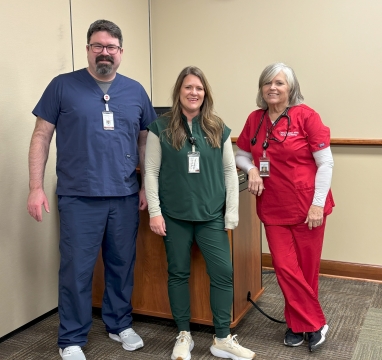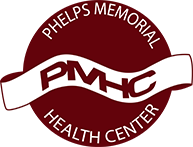Phelps Memorial Health Center recently hosted its Heart Healthy Wellness Night, delivering a dual-focused presentation on vein disease and coronary artery disease as well as a tour of the facility's catheterization laboratory.
Cheryl Klausen, APRN, presented vital information about coronary artery disease, while Sadie Johnson, PA-C, shared insights about vein disease and treatment options. Attendees had the unique opportunity to tour the Cath Lab facilities and view a heart catheterization procedure via video demonstration, providing a rare behind-the-scenes look at cardiac diagnostic procedures.
Sadie Johnson, PA-C, shared statistics about vein disease, revealing that more than 40 million Americans suffer from undiagnosed vein disease, with only one percent of those diagnosed seeking treatment. This common but often overlooked condition affects nearly a quarter of the population.
Johnson said venous disease in the veins of the legs is not life-threatening, but it can cause you problems.
Venous disease of the legs occurs when the veins struggle to send blood back to the heart, leading to blood pooling in the legs. This condition can cause symptoms such as leg pain, swelling, heaviness, fatigue, and visible varicose veins. As it progresses, skin changes like discoloration or ulcers may develop.
To manage venous disease, lifestyle changes like regular exercise, elevating the legs, and wearing compression stockings can help. In more advanced cases, medical treatments such as minimally invasive procedures to close or remove affected veins may be recommended.
Johnson outlined several risk factors for vein disease, including genetic predisposition, age, gender, height, obesity, prolonged standing, and pregnancy. She explained the fundamental differences between arteries and veins.
The presentation highlighted various treatment options available at Phelps Memorial, including the VenaSeal procedure and the Varithena procedure. Both have demonstrated significant symptom improvement for patients.
VenaSeal is an innovative, minimally invasive procedure used to treat varicose veins. VenaSeal uses a medical adhesive to close the affected vein, rerouting blood flow to healthier veins. This technique reduces pain and bruising while allowing patients to quickly return to their daily activities.
The procedure involves a small catheter being inserted into the vein, delivering the adhesive to seal it shut. Over time, the body naturally absorbs the closed vein.
Varithena, on the other hand, uses a foam sclerosant that is injected into the vein, causing it to collapse and be reabsorbed by the body. It is particularly effective for twisted or hard-to-reach veins.
A key takeaway from Johnson was the importance of early intervention and conservative treatment options, such as compression socks.
Johnson said, “Compression socks do not fix the disease, but they will keep it where it is at. If you have venous disease, they are very effective.” She suggested the athletic type of compression socks because they are better tolerated by many.
Compression socks are a simple yet powerful tool for managing varicose veins. They apply gentle pressure to the legs, helping veins move blood more efficiently back to the heart. This reduces swelling, pain, and the risk of blood clots. They are particularly useful for people who stand or sit for long periods.
Cheryl Klausen, APRN, discussed coronary artery disease (CAD) and the evolution of stents. Over the years, the treatment of CAD has significantly evolved with the development of angioplasty and stents.
Angioplasty is a minimally invasive procedure that uses a balloon to widen the narrowed artery, restoring blood flow. To prevent the artery from closing again, a stent is often placed to keep it open. Early stents were made of bare metal, but modern advancements have led to drug-eluting stents that slowly release medication to reduce the risk of re-narrowing. These innovations have greatly improved outcomes for CAD patients, offering quicker recovery times and longer-lasting results.
Klausen said that coronary artery disease is a more specific diagnosis than having just “heart problems”.
She said, “If you think of your heart as a house, coronary artery disease is the plumbing of the house. Your house isn’t going to function right if the plumbing doesn’t work right.”
Coronary artery disease (CAD) occurs when the coronary arteries that supply blood to the heart become narrowed or blocked due to plaque buildup, leading to chest pain, shortness of breath, or even heart attacks.
“Coronary disease is a progressive disease,” said Klausen. “What we are finding is that we can identify it so much earlier. We find it before damage has happened.”
Heart disease is the number one killer in America and it’s important to work with your primary medical providers who can guide you.
Klausen told attendees about a fairly new way to find blockages, the Coronary Artery Cat Scans, for people who have risk factors for coronary artery disease.
Klausen said the risk factors for Coronary Artery Disease are high blood pressure, high cholesterol, a family history of premature coronary heart disease, diabetes, and a history of smoking.
The scans show if calcium is building up along coronary arteries. It helps detect plaque buildup and blockages that could lead to heart disease or heart attacks. By providing a clear view of the arteries without the need for catheterization, this scan allows doctors to assess heart health quickly and accurately.
Those interested in learning more about CAD, Calcium screenings, vein disease evaluation, or other treatment options can contact their primary medical provider, contact the cardiology clinic at 308-995-2838, or schedule an evaluation at 308-995-3305.



